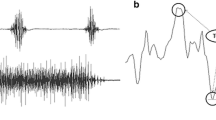Summary
Twelve male subjects were tested to determine the relationship between motor unit (MU) activities and surface electromyogram (EMG) power spectral parameters with contractions increasing linearly from zero to 80% of maximal voluntary contraction (MVC). Intramuscular spike and surface EMG signals recorded simultaneously from biceps brachii were analyzed by means of a computer-aided intramuscular MU spike amplitude-frequency (ISAF) histogram and an EMG frequency power spectral analysis. All measurements were made in triplicate and averaged. Results indicate that there were highly significant increases in surface EMG amplitude (71±31.3 to 505±188 μV,p<0.01) and mean power frequency (89±13.3 to 123±23.5 Hz,p<0.01) with increasing force. These changes were accompanied by progressive increases in the firing frequency of MU's initially recruited, and of newly recruited MU's with relatively larger spike ampltitudes. The group data in the ISAF histograms revealed significant increases in mean spike amplitude (412±79 to 972±117 μV,p<0.01) and mean firing frequency (17.8±5.4 to 24.7±4.1 Hz,p<0.01). These data suggest that surface EMG spectral analysis can provide a sensitive measure of the relative changes in MU activity during increasing force output.
Similar content being viewed by others
References
Bigland-Ritchie B (1981) EMG/force relations and fatigue of human voluntary contractions. Exerc Sport Sci Rev 9:75–117
Broman H, Bilotto G, De Luca CJ (1985) Myoelectric signal conduction velocity and spectral parameters: influence of force and time. J Appl Physiol 58:1428–1437
De Luca CJ, Creigh JL (1985) Do the firing statistics of motor units modify the frequency content of the EMG signal during sustained contractions? In: Winter DA (ed) Biomechanics IX-A. Human Kinetics Publishers, Ill, pp 358–362
De Luca CJ, LeFever RS, McCue MP, Xenakis AP (1982) Behaviour of human motor units in different muscles during linealy varying contractions. J Physiol (Lond) 329:113–128
deVries HA (1968) “Efficiency of electrical activity” as a physiological measure of the functional state of muscle tissue. Am J Phys Med 47:10–22
Clamann HP (1970) Activity of single motor units during isometric tension. Neurology 20:254–260
Clarke HH (1966) Muscle strength and endurance in man. Prentice-Hall Inc, New Jersey
Denny-Brown D (1949) Interpretation of the electromyogram. Arch Neurol Psychiat 61:99–128
Fruend HJ, Budingen HJ, Dietz V (1975) Activity of single motor units from human forearm muscles during voluntary isometric contractions. J Neurophysiol 38:993–946
Goldberg LJ, Derfler B (1977) Relationship among recruitment order, spike amplitude, and twitch tension of single motor units in human masseter muscle. J Neurophysiol 40:879–890
Hagberg M, Ericson BE (1982) Myoelectric power spectrum dependence on muscular contraction level of elbow flexors. Eur J Appl Physiol 48:147–156
Henneman E, Olson CB (1965) Relations between structure and function in the design of skeletal muscle. J Neurophysiol 28:581–597
Henneman E, Somjem G, Carpenter DO (1965) Functional significance of cell size in spinal motoneurons. J Neurophysiol 28:560–580
Komi PV, Viitasalo JHT (1976) Signal characteristics of EMG at different levels of muscle tension. Acta Physiol Scand 96:267–276
Kukulka CG, Clamann HP (1981) Comparison of the recruitment and discharge properties of motor units in human brachial biceps and adductor pollics during isometric contractions. Brain Res 219:45–55
Largo P, Jones NB (1977) Effect of motor-unit firing time statistics on e.m.g. spectra. Mol Biol Eng Comput 15:648–655
Lindström L, Magnusson R, Petersen I (1970) Muscle fatigue and action potential conduction velocity changes studied with frequency analysis of EMG signals. Electromyogr Clin Neurophysiol 4:341–353
Miler-Brown HS, Stein RB, Yemm R (1973) Changes in firing rate of human motor units during linearly changing voluntary contractions. J Physiol (Lond) 230:371–390
Moritani T, deVries HA (1978) Reexamination of the relationship between the surface integrated electromyogram (IEMG) and force of isometric contraction. Am J Phys Med 57:263–277
Moritani T, deVries HA (1979) Neural factors versus hypertrophy in the time course of muscle strength gain. Am J Phys Med 58:115–130
Moritani T, Gaffney FD, Charmichael T, Hargis J (1985a) Interrelationships among muscle fiber types, electromyogram, and blood pressure during fatiguing isometric contraction. In: Winter DA (ed) Biomechanics IX-A. Human Kinetics Publishers, Ill, pp 287–292
Moritani T, Muro M, Kijima A, Berry MJ (1986a) Intramuscular spike analysis during ramp force and muscle fatigue. Electromyogr Clin Neurophysiol 26:147–160
Moritani T, Muro M, Kijima A, Gaffney FA, Parsons D (1985b) Electromechanical changes during electrically induced and maximal voluntary contractions: surface and intramuscular EMG responses during sustained maximal voluntary contraction. Exp Neurol 88:484–499
Moritani T, Muro M, Nagata A (1986b) Intramuscular and surface electromyogram changes during muscle fatigue. J Appl Physiol 60:1179–1185
Moritani T, Nagata A, Muro M (1982) Electromyographic manifestations of muscular fatigue. Med Sci Sport Exerc 14:198–202
Muro M, Nagata A, Moritani T (1983) Analysis of myoelectric signals during dynamic and isometric contractions. In: Matsui H, Kobayashi K (eds) Biomechanics VIII-A. Human Kinetics Publishers, Ill, pp 432–439
Petrofsky JS, Lind AR (1980a) Frequency analysis of the surface electromyogram during sustained isometric contractions. Eur J Appl Physiol 43:173–182
Petrofsky JS, Lind AR (1980b) The influence of temperature on the amplitude and frequency components of the EMG during brief and sustained isometric contractions. Eur J Appl Physiol 44:189–200
Stephens JA, Taylor A (1972) Fatigue of maintained voluntary muscle contraction in man. J Physiol (Lond) 220:1–18
Tanji J, Kato M (1973) Recruitment of motor units in voluntary contraction of a finger muscle in man. Exp Neurol 40:759–770
Zuniga EN, Simons DG (1969) Nonlinear relationship between averaged electromyogram potential and muscle tension in normal subjects. Arch Phys Med Rehab 50:613–619
Author information
Authors and Affiliations
Rights and permissions
About this article
Cite this article
Moritani, T., Muro, M. Motor unit activity and surface electromyogram power spectrum during increasing force of contraction. Europ. J. Appl. Physiol. 56, 260–265 (1987). https://doi.org/10.1007/BF00690890
Accepted:
Issue Date:
DOI: https://doi.org/10.1007/BF00690890




